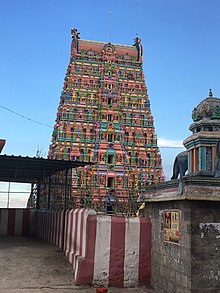Subramaniya Swamy Temple, Tiruttani
This article needs additional citations for verification. (September 2018) |
| Subramaniya Swamy Temple, Tiruttani | |
|---|---|
அருள்மிகு சுப்பிரமணிய சுவாமி திருக்கோயில் | |
 tiruttanitemple.com | |
| Religion | |
| Affiliation | Hinduism |
| District | Thiruvallur |
| Deity | Murugan |
| Festivals | Aadi Kirthika |
| Location | |
| Location | Tiruttani |
| State | Tamil Nadu |
| Country | India |
| Geographic coordinates | 13°10′18.6″N 79°36′13.57″E / 13.171833°N 79.6037694°E |
| Architecture | |
| Type | Tamil architecture |
| Website | |
| https://tiruttanitemple.com/ | |
The Subramaniya Swamy Temple[1] is a Hindu temple, on the hill of Tiruttani, Tiruvallur district, Tamil Nadu, India, dedicated to Murugan. The hill has 365 steps indicating 365 days of the year. It is fifth among the six abodes of Murugan (Arupadai Vidu) The other five are Palani Murugan Temple, Swamimalai Murugan Temple, Thiruchendur Murugan Temple, Thiruparankundram and Pazhamudircholai Murugan Temple. Tiruttani is 87 kilometres (54 mi) from Chennai. It is the only adobe located within the Greater Chennai Metropolitan Area limit. During the Sangam era, Tiruttani was known as Kundruthoradal. After killing the asura Tarakasura in Tiruchendur, he came here to subside his anger, so Surasamharam is not conducted here.[citation needed]
History[edit]
The origins of this temple, are buried in antiquity. This temple has been mentioned in the Sangam period work Tirumurugatruppadai composed by Nakkeerar. It has been patronized by the Vijayanagara rulers and local chieftains and zamindars. The original animal mount of Murugan is believed to have been an elephant, compared to the peacock which is considered to be the most common mount. The white elephant, is considered a powerful, terror striking animal. The iconography is maintained only in two places, namely, this temple and Tiruttani Murugan Temple.[citation needed]

Legend[edit]
According to the regional legend of the temple, Indra, the king of the devas gave his daughter Devasena in marriage to Murugan, and along with her presented his elephant Airavata as part of his offering. Upon Airavata's departure, Indra found his wealth waning. Murugan is said to have offered to return the white elephant, however Indra bound by protocol refused to accept a gift that he had made, and insisted that the elephant face his direction, hence the image of the elephant in this temple also faces the east. [citation needed] Another legend has it that Indra presented a sandal stone as a part of his daughter's gift. The sandal paste made on this stone is applied to the image of Murugan and the applied paste is said to acquire medicinal value. Murugan is also believed to have imparted knowledge of Tamil to the sage Agastya and he is heralded with the epithets Veeramurti, Jnanamurti, and acharyamurti in this shrine. [citation needed]
On worshipping at Thanikai, the king of the snakes, Vasuki got his bodily wounds healed, which had been caused during the Samudra Manthana to secure the amrita (nectar of immortality) by the devas and asuras when the Mandara mountain was used as the churning base and the snake king Vasuki as the rope. Sage Agastya worshipped Murugan at Tanikai when he was blessed with the divine gift of the Tamil language.
Architecture[edit]

The temple is located on a hill named Thanigai hill reached with 60 steps. The temple has a five-tiered gopuram and four precincts. There are several water bodies associated with the temple. The temple has two shrines, namely, Murugan in the form of Shaktidharar and the shrines of Valli and Devasena in two other shrines.[2]
Religious significance[edit]
Apart from its puranic greatness, Saint Arunagirinathar has praised this hill as the chosen place for worship by devas and the favorite abode of saints performing prolonged tapas. He also compared this hill to Shivaloka (Kailasha) and as the very soul of the world. Sri Muthuswami Dikshitar, who lived 200 years ago (one of the trinity of Carnatic music) had his inspiration in Tiruttani when Murugan (in the guise of an old man) met him on the steps and sweetened his tongue with the prasadam of this temple, which impelled him to compose and render his first kriti "Sri Nathadhi Guruguho Jayati Jayati" (song) Murugan of Tanikai. The temple vimanam was covered by gold.[citation needed]
Administration[edit]
The temple is maintained and administered by the Hindu Religious and Charitable Endowments Department of the Government of Tamil Nadu.[3]
Timings[edit]
Usually the temple is open from 5:45 a.m. to 21:00 . On special days, the temple is open full day in between 12pm to 3 pm is closed on some festival time[4]
Festivals[edit]
Besides the monthly Karthikai's which attract a large number of devotees to this shrine, the two outstanding annual festivals are the Aadi Krittikai and 31 December New Year Step Festival. The float festival is celebrated in the month of Adi, Brahmotsavam in the month of Masi, during which Valli Kalyanam is celebrated on the 8th day, and the Murugan Shashti is celebrated in the Tamil month of Aippasi.[citation needed]
Aadi Karthigai[edit]
Aadi Karthigai festival (in July–August) lasts for three days with Float Festival when hundreds of thousands of devotees come to this holy place from far and near.[citation needed]
Notes[edit]
- ^ https://tiruttanitemple.com/
- ^ V., Meena (1974). Temples in South India (1st ed.). Kanniyakumari: Harikumar Arts. p. 48.
- ^ Hindu Religious and Charitable Endowments Act, 1959
- ^ "Tiruttani Murugan - Arulmigu Subramanya Swamy Temple". 27 January 2024. Retrieved 9 February 2024.
References[edit]
- Zvelebil, Kamil V. (1991). Tamil traditions on Subramanya - Murugan (1st ed.). Chennai, India: Institute of Asian Studies.
- "Sri Subramaniaswami temple". Dinamalar. Retrieved 17 March 2013.
External links[edit]
- Official Temple page
- Murugan Temples Archived 11 November 2006 at tiruttanitemple.com (Error: unknown archive URL)

